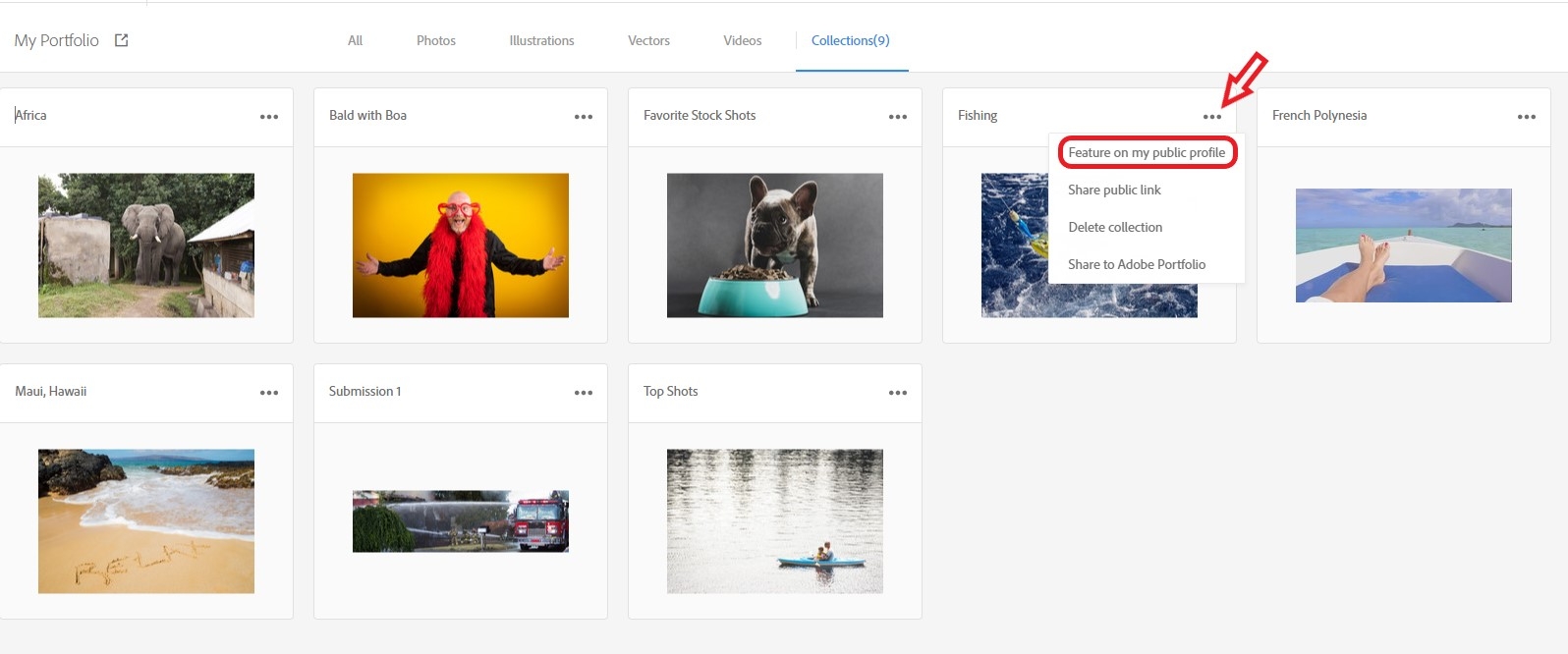Are you a photographer, illustrator, or graphic designer looking to monetize your creativity? The Adobe Stock Contributor Program might be just what you need! This program allows you to sell your images, videos, and illustrations to a vast audience of Adobe users, providing an excellent opportunity to earn passive income from your work. With millions of people searching for high-quality visuals to enhance their projects, contributing to Adobe Stock can turn your passion into profit!
Getting Started as an Adobe Stock Contributor

Embarking on your journey as an Adobe Stock Contributor is both exciting and straightforward. Here’s how to get started:
- Sign Up: First things first, you need to create an Adobe ID if you don’t already have one. Simply visit the Adobe Stock Contributor page and click on “Join now.” Follow the prompts to set up your account.
- Understand the Guidelines: Before you start uploading your work, take some time to familiarize yourself with Adobe's submission guidelines. They provide information about image quality, file formats, and legal requirements, which are crucial for approval.
- Prepare Your Portfolio: It’s essential to showcase your best work. Aim for a diverse collection that highlights your unique style. You might want to include:
- High-resolution photographs
- Vector illustrations
- Videos
- Unique concepts or trending themes
Keep in mind that quality matters more than quantity. A small number of high-quality submissions can perform better than a large number of mediocre ones.
Uploading Your Work: Once you’ve prepared your portfolio, you can start uploading your images or videos. Here’s how:
- Log in to your Adobe Stock Contributor account.
- Click on “Upload” and select the files you want to submit.
- Fill in the metadata for each project, including titles, descriptions, and keywords. This is crucial for searchability, so choose your words wisely!
- Submit your content for review.
Adobe typically reviews submissions within a few days. If your work is accepted, it’ll be available for buyers worldwide. If not, don’t get discouraged! Use the feedback to improve your future submissions.
Marketing Your Work: After you’ve successfully uploaded your creations, consider strategies for marketing them effectively:
- Use Social Media: Share your Adobe Stock profile or specific images across your social media platforms. Engaging posts can drive traffic and generate sales.
- Create a Website or Blog: Showcase your portfolio outside of Adobe Stock. A personal website can attract customers directly and feature links to your Adobe Stock contributions.
- Network with Other Creators: Join groups or forums where creatives share experiences and tips. Networking can lead to collaborations and further opportunities.
By following these steps and continuously improving your craft, you’ll be well on your way to becoming a successful Adobe Stock Contributor. Remember, persistence is key, and the more you engage with the platform, the better your chances for success!
Also Read This: Enhance Your YouTube Shorts with Creative Effects
3. Understanding the Requirements for Submission

Jumping into the world of stock photography can be exciting, but it's essential to understand the submission requirements that Adobe Stock has in place. This will not only help you avoid rejections but also streamline your workflow. Here’s what you need to know:
Image Quality: Adobe Stock has strict quality standards. Your images should be sharp, well-composed, and properly exposed. Avoid images that are blurry or pixelated, as these will likely be rejected. Always shoot in a high resolution—typically, a minimum of 4-megapixels is considered acceptable.
File Format: When submitting your photos, make sure they are in either JPEG format. This is not just about compatibility; JPEGs are compressed, making them easier to upload without losing significant quality.
Keywording: Keywords are your ticket to visibility on Adobe Stock. Use relevant and specific keywords to describe your image accurately. This helps potential buyers find your photos easily. Adobe recommends using a mix of broad and specific terms; for example, if you have a photo of a sunset over a lake, use keywords like "sunset," "lake," "nature," and "peaceful" to capture various search intents.
Model and Property Releases: If your photo features identifiable people or private properties, you need to have appropriate releases signed. These documents protect you and Adobe from legal issues over usage rights. Make sure to understand how to complete these releases before planning your shoots.
No Copyrighted Material: Avoid using copyrighted material in your photos. This includes logos, branded products, and recognizable artworks. Everything in your image must be your own work or released to you with proper permissions.
Keep these requirements in mind to ensure a smooth submission process. Prepare your images wisely, and you'll soon find yourself on the right path to becoming a successful contributor to Adobe Stock.
Also Read This: How to Insert an Image into an EPUB File for Customized E-books
4. Tips for Creating High-Quality Stock Photos
Creating high-quality stock photos is not just about having a good camera; it’s about understanding what sells and how to engage your audience. Here are some handy tips to elevate your stock photography:
- Know Your Audience: Understand the market trends and what types of images buyers are seeking. Check Adobe Stock to see which images are popular in your niche. This kind of research can inspire your next shoot!
- Focus on Composition: The rule of thirds, leading lines, and balanced framing can significantly impact the quality of your images. Experiment with different angles and perspectives to make your photos stand out.
- Lighting Matters: Proper lighting can make or break a photograph. Natural light is often your best friend, especially during the golden hour—just after sunrise and before sunset. If you're shooting indoors, soft diffused light can create a pleasing atmosphere.
- Post-Processing: Don’t skip the editing phase! Use software like Adobe Lightroom or Photoshop to enhance your images. Basic adjustments like brightness, contrast, and color correction can dramatically improve your photos.
- Think Outside the Box: Unique or unconventional subjects can attract buyers. Think creatively and experiment with different themes or concepts that haven’t been overly saturated in the market.
- Consistency is Key: While it's great to experiment, developing your style can help you build a brand. Maintaining a consistent quality and theme across your photos will help you build recognition and trust among buyers.
Remember, creating successful stock photos takes practice and patience. Keep shooting, learn from your submissions, and before you know it, you’ll see your portfolio grow! Happy snapping!
Also Read This: Mastering the Behance App for Effective Mobile Portfolio Management
5. How to Optimize Your Photos for Searchability
So, you've captured some stunning images and uploaded them to Adobe Stock. That's fantastic! But how do you ensure that potential buyers find your work amidst the vast sea of images? The key lies in optimization for searchability. Let’s dive into some effective strategies!
1. Use Relevant Keywords: Start with a thoughtful keyword strategy. Think about the terms that a buyer might type in a search bar. Use a mix of general and specific keywords. For example, if your photo is of a sunset over a mountain, you could use keywords like “sunset,” “mountain,” “nature,” “landscape,” and “scenic view.” Aim for about 10-15 keywords that accurately describe your image.
2. Write a Descriptive Title: Craft a title that captures the essence of your photo. Avoid generic titles such as “Image1234.” Instead, go for something like “Breathtaking Sunset Over Rocky Mountains.” This not only grabs attention but also aids in SEO.
3. Add Detailed Descriptions: A well-written description gives context to your image. It’s a perfect place to elaborate on what’s happening in the photo. Here’s a quick template: “A serene sunset over the Rocky Mountains, capturing the vibrant hues of orange and pink as day turns to night. This scenic landscape is perfect for travel blogs, nature magazines, and more.” The more detail you provide, the better buyers can understand and appreciate your work.
4. Use Categories Wisely: Adobe Stock allows you to categorize your images. Choose categories that best fit your photos. This helps in narrowing down the search results for potential buyers looking for specific themes or styles.
5. Tag Location: If your photo features a specific location, make sure to tag it. Location-based searches are quite common, and your images might just be what someone is looking for when they search by a particular place.
With these tips, you should be well on your way to optimizing your photos for searchability. Remember, it’s all about making it easy for buyers to find your amazing work!
Also Read This: How to Become a Model for Adobe Stock Images
6. Marketing Your Adobe Stock Portfolio
Launching your portfolio on Adobe Stock is only the beginning. To truly thrive as a successful contributor, you need to actively market your work. Here’s how you can put your portfolio on the map!
1. Utilize Social Media: Social media platforms like Instagram, Pinterest, and Facebook can be powerful tools for showcasing your photography. Create a dedicated account for your stock photography where you can regularly post your images with links to your Adobe Stock portfolio. Engaging with your audience and using relevant hashtags can significantly increase your visibility.
2. Build a Personal Website: Having your own website not only establishes your brand but also serves as a portfolio for potential clients and buyers. Make sure to include a link to your Adobe Stock portfolio on your site. A blog section where you share behind-the-scenes looks, tips, or photography stories could also draw more visitors to your work.
3. Network with Other Creatives: Collaboration is key in the creative industry. Engage with other photographers and creatives. You can feature each other’s work, which can help expand your reach. Consider joining online photography communities or forums to connect with like-minded artists.
4. Email Marketing: Don’t underestimate the power of a good email list. Gather emails from interested buyers or fellow photographers, and send out regular newsletters. Share updates about new images in your portfolio, promotions, or upcoming projects. This keeps your audience engaged and informed.
5. Participate in Competitions: Enter photography competitions and challenges. Winning or even participating can gain your work exposure. Many competitions allow you to showcase your Adobe Stock portfolio when presenting your entries, giving you that added visibility.
By actively marketing your Adobe Stock portfolio using these strategies, you can significantly increase your chances of success. Remember, consistency is key, and cultivating a brand around your photography takes time and effort. So keep sharing, engaging, and showcasing your unique perspective through your lens!
Also Read This: How to Put an Image on a Shirt: Step-by-Step Guide for Custom Apparel
7. Common Mistakes to Avoid as a Stock Contributor
Entering the world of stock photography can be exhilarating, but it's not without its pitfalls. As you dive into becoming a successful contributor to Adobe Stock Photos, it’s essential to be aware of some common mistakes that can hinder your success. Here are a few crucial blunders to steer clear of:
- Poor Image Quality: One of the most significant mistakes is uploading images that lack quality. Ensure your photos are well-lit, in focus, and free from noise. Stock photo buyers expect high-resolution, professional-looking images.
- Ignoring Metadata: Failing to add descriptive titles, tags, and keywords can drastically reduce your visibility. Take the time to write engaging and relevant metadata that accurately describes your images.
- Neglecting Legal Aspects: Always consider the legalities, such as model releases if people are recognizable in your photos. Not having the proper permissions can lead to rejected submissions and potential legal issues.
- Uploading Similar Images: While it might be tempting to submit multiple versions of the same shot, it often dilutes your portfolio. Instead, focus on submitting a diverse range of work that showcases different styles and subjects.
- Lack of Consistency: It's essential to develop a consistent style that can be recognized as your own. Jumping from one theme to another can confuse potential buyers about what your work represents.
- Not Knowing Your Audience: Understanding what buyers are looking for can significantly influence your success. Research trending topics and themes to align your contributions with market demands.
- Overlooking Trends: Trends in stock photography change constantly. Failing to keep an eye on current trends can lead to irrelevant submissions. Regularly update your portfolio to reflect what is popular and in demand.
By staying mindful of these common pitfalls, you can enhance your portfolio and increase your chances of success on Adobe Stock. Remember, every missed opportunity is a chance to learn, so don't be discouraged if you encounter setbacks as you grow in your journey.
Also Read This: How to Record a Video on YouTube for Beginners
8. Benefits of Being an Adobe Stock Contributor
Joining the Adobe Stock community as a contributor isn’t just about selling images; it opens up a world of benefits that can help both budding and seasoned photographers thrive in the stock market. Here’s why becoming a contributor is a fantastic opportunity:
- Passive Income: One of the most appealing aspects is that contributors can earn passive income. Once your photos are uploaded, you can continue earning royalties each time they’re downloaded without any additional effort.
- Global Exposure: Adobe Stock is part of the Adobe Creative Cloud ecosystem, giving your work access to millions of potential buyers worldwide. This level of exposure can be hard to achieve independently.
- Creative Freedom: You have the liberty to create what you love. There’s no strict guideline on the subjects you can photograph, allowing you to express your creativity freely while making a profit.
- Community Support: As a contributor, you get to connect with a vibrant community of fellow photographers. This network can provide you with valuable tips, inspiration, and support throughout your journey.
- Growth Opportunities: Adobe Stock frequently offers resources, webinars, and tutorials designed to help you improve your skills and market your work more effectively. Take advantage of these to enhance your craft!
- User-Friendly Platform: The submission process is streamlined and intuitive. Adobe makes it easy to upload your work, track your sales, and manage your portfolio without unnecessary complications.
- Feedback and Reviews: You receive valuable feedback from the platform regarding trends and what buyers are looking for, helping you refine your approach and improve your future submissions.
So, if you're considering taking the plunge and contributing to Adobe Stock Photos, know that the effort you put in can yield rewarding results. The journey might have its challenges, but the benefits are undeniably worthwhile!
Conclusion and Next Steps for Aspiring Contributors
Becoming a successful contributor to Adobe Stock Photos is an exciting journey that blends creativity with business acumen. By following the strategies outlined in this blog post, you can position yourself to thrive in the competitive world of stock photography.
As you embark on this path, keep these key takeaways in mind:
- Focus on Quality: Ensure that your images meet high-resolution standards and are technically sound.
- Understand Market Trends: Stay updated with current trends and popular themes in stock photography.
- Utilize Keywords Effectively: Use relevant and targeted keywords to make your images easily discoverable.
- Build a Diverse Portfolio: Include a mix of styles, subjects, and formats to attract a wider audience.
- Engage with the Community: Connect with other contributors to share experiences and gain insights.
Next, consider the following steps to kickstart your Adobe Stock journey:
- Set up your Adobe Stock account and familiarize yourself with the submission guidelines.
- Create and curate a body of work that highlights your unique style and perspective.
- Regularly upload new content to keep your portfolio fresh and relevant.
- Monitor your performance analytics to understand which images resonate most with buyers.
In conclusion, with dedication and a strategic approach, you can carve out a successful niche for yourself as an Adobe Stock contributor. Embrace the learning process, stay persistent, and watch your contributions gain traction in the expansive stock photography marketplace.
 admin
admin








